|
|
 |
Fiche d'espèce de Copépode |
|
|
Calanoida ( Ordre ) |
|
|
|
Clausocalanoidea ( Superfamille ) |
|
|
|
Aetideidae ( Famille ) |
|
|
|
Aetideus ( Genre ) |
|
|
| |
Aetideus giesbrechti Cleve, 1904 (F,M) | |
| | | | | | | Syn.: | Aëtidius armatus : Giesbrecht, 1892 (p.213, figs.F,M); A. armatus : Giesbrecht & Schmeil, 1898 (p.31);
Aethidius giesbrechti Cleve, 1904 a (p.185);
Aetidius giesbrechti : Wolfenden, 1911 (p.209, figs.F);
? Aetideus mediterraneus Steuer, 1910 a (p.23);
Euaetideus giesbrechti : Sars, 1925 (p.42, figs.F); Rose, 1933 a (p.90, figs.F); Farran, 1936 a (p.87, Rem.: juv.); Massuti Alzamora, 1942 (p.89, figs.F, Rem.); Wilson, 1942 a (p.183); Lysholm & al., 1945 (p.11); Sewell, 1948 (p.347, 499, 508, 545, 548, 555, 566); C.B. Wilson, 1950 (p.203); Vervoort, 1952 a (n°42, p.3, figs.F); 1957 (p.6, 49, Redescr.F, figs.F); Fagetti, 1962 (p.17); Gaudy, 1962 (p.93, 99, Rem.: p.105); Grice, 1962 (p.190, figs.F, Rem.); Paiva, 1963 (p.30, figs.F, juv.M); V.N. Greze, 1963 a (tabl.2); Shmeleva, 1963 (p.141); Gaudy, 1963 (p.22, Rem.); Björnberg, 1963 (p.36, Rem.); De Decker & Mombeck, 1964 (p.12); Grice & Hulsemann, 1965 (p.223); Chen & Zhang, 1965 (p.50, figs.F); Pavlova, 1966 (p.43); Neto & Paiva, 1966 (p.23, Table III); Saraswathy, 1966 (1967) (p.76); Fleminger, 1967 a (tabl.1); Owre & Foyo, 1967 (p.43, figs.F); Evans, 1968 (p.13); Berdugo & Kimor, 1968 (p.447); Vinogradov, 1968 (1970) (p.268); De Decker, 1968 (p.45); Dowidar & El-Maghraby, 1970 (p.268); Deevey, 1971 (p.224); Bowman, 1971 b (p.5); Razouls C., 1972 (p.94, Annexe: p.40, figs.F); Razouls S., 1972 b (p.1, respiration); Apostolopoulou, 1972 (p.327, 345); Roe, 1972 (p.277, tabl.1, tabl.2); 1972 a (p.332); Bradford, 1972 (p.36, figs.F); Kos, 1972 (Vol. I, figs.F, M, Rem.); Binet & al., 1972 (p.69); Bainbridge, 1972 (p.61, Appendix Table I: vertical distribution vs day/night, Table II: %); S. Razouls, 1974 (147, oxygen rate); Vives & al., 1975 (p.42, tab.II, III, IV); Frontier, 1977 a (p.14); Deevey & Brooks, 1977 (p.256, tab.2, Station "S"); Carter, 1977 (1978) (p.35); Binet, 1979 (p.400); Dessier, 1979 (p.204); Vaissière & Séguin, 1980 (p.23, tab.2); Björnberg & al., 1981 (p.604, 630, figs.F); Vives, 1982 (p.290); Greze & al., 1983 (p.17); Dessier, 1983 (p.89, Tableau 1, Rem., %); Guangshan & Honglin, 1984 (p.118, tab.); De Decker, 1984 (p.316); Scotto di Carlo & al., 1984 (1042); Regner, 1985 (p.11, Rem.: p.30); Moraitou-Apostolopoulou, 1985 (p.303, occurrence/abundance in E Mediterranean Sea, Rem.: p.309); Chen Y.-Q., 1986 (p.205, Table 1: abundance %, Table 2: vertical distribution); Madhupratap & Haridas, 1986 (p.105, tab.1); Valentin & al., 1987 (p.1202); Jimenez-Perez & Lara-Lara, 1988; Lozano Soldevilla & al., 1988 (p.58); Suarez & al., 1990 (tab.2); Pancucci-Papadopoulou & al., 1990 (p.199); Scotto di Carlo & al., 1991 (p.271); Suarez & Gasca, 1991 (tab.2); Suarez, 1992 (App.1); Shih & Young, 1995 (p.67); Lopez-Salgado & Suarez-Morales, 1998 (p.319); Siokou-Frangou, 1999 (p.476); Bradford-Grieve & al., 1999 (p.879, 920, figs.F,M); Lopes & al., 1999 (p.215, tab.1); Lopez-Salgado & al., 2000 (tab.1); Hwang & al., 2003 (p.193, tab.2); Vukanic, 2003 (139, tab.1); Isari & al., 2006 (p.241, tab.II); Morales-Ramirez & Suarez-Morales, 2008 (p.517); Gaard & al., 2008 (p.59, Table 1, N Mid-Atlantic Ridge); Licandro & Icardi, 2009 (p.17, Table 4); Zaafa & al., 2014 (p.67, Table I, occurrence):
Aetideus (Euaetideus) giesbrechti: Hernandez-Trujillo, 1991 (1993) (tab.I) | | | | Ref.: | | | Farran, 1908 b (p.29); A. Scott, 1909 (p.36, figs.F, Rem.); Pesta, 1920 (p.508); Farran, 1929 (p.208, 228); Mori, 1937 (1964) (p.38, figs.F); Chiba, 1957 & al. (p.308); 1957 a (p.12); Tanaka, 1957 a (p.33); Mazza, 1967 (p.111, 138, figs.juv., F,M); 1968 (p.531: Rem., figs.); Bradford, 1971 (p.28, figs.F,M); Park, 1974 (p.220, figs.F,M); Chahsavar-Archad & Razouls, 1982 (p.28, fig.M); Bradford & Jillett, 1980 (p.14, figs.F, M, fig. 73, distribution chart); Razouls,1994 (p.64, figs.F,M); Markhaseva, 1996 (p.18, figs.F,M); Chihara Murano, 1997 (p.682, Pl.33: F); Conway & al., 2003 (p.173, figs.F,M, Rem.); Vives & Shmeleva, 2007 (p.546, figs.F,M, Rem.) | 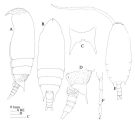 issued from : J.M. Bradford & J.B. Jillett in Mem. N.Z. Oceanogr. Inst., 86, 1980. [p.17, Fig.7] Female: A, B, habitus (lateral, dorsal); C, Rostrum; D, last thoracic segment and Urosome (lateral left side). Male: E, habitus (ventral); F, P5.
|
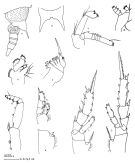 issued from : J.M. Bradford in N.Z. Jl Mar. Freshw. Res., 1971, 5 (1). [p.29, Fig.11]. Female (from SW Pacific): a, posterior part of metasome and uropode (lateral left side); b, rostrum; c, A2; d, Md (mandibular palp); e, Mx1; f, Mx2; g, Mxp; h, P1; i, P2; j, P3; k, 1st basipod segment of P4. Nota: The limbs are very similar to those of A. armatus except that the 1st endopod segment of Mx1 bears 3 setae. The posterior thoracic segment, anterior head and genital segment are covered with conspicuous chitinous thickenings. The 1st basipod of P4 has a row of small internal spines. The present female specimens differ from Vervoort's (1957) description but are similar to Grice's (1962) figures.
|
 issued from: Q.-c Chen & S.-z. Zhang in Studia Marina Sinica, 1965, 7. [Pl.13, 1-5]. As Euaetideus giesbrechti. Female (from E China Sea): 1, habitus (dorsal); 2, idem (lateral right side); 3, rostrum (anterior view); 4, P1 (anterior); 5, 1st and 2nd urosomal segments (ventral).
|
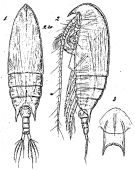 Issued from: G.O. Sars in Résult. Camp. Scient. Prince Albert I, 69, pls.1-127 (1924). [Pl.XIV, figs. 1-3]. As Euaetideus giesbrechti. Female: habitus (dorsal); 2, idem (lateral left side); 3, rostrum (frontal view).
|
 issued from : A. Scott in Siboga-Expedition, 1909, XIX a. [Plate IV, Figs.1-13]. Female (from Indonesia-Malaysia): 1, habitus (dorsal); 2, forehead (lateral); 3, last thoracic and genital segments (left side); 4, rostrum; 5, A1; 6, A2; 7, Md; 8, Mx1; 9, Mx2; 10, Mxp; 11, P1; 12, P2; 13, P4.
|
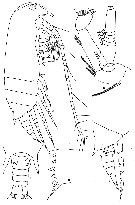 issued from : W. Vervoort in B.A.N.Z. Antarctic Reseach Expedition, Report Ser. B, Vol. III., 1957 [Fig.24]. As Euaetideus giesbrechti. Female (from E Indian): a, habitus (lateral); b, left A2; c, e, posterior part cephalothorax and urosome (dorsal and lateral, respectively); d, Md (cutting edge).
|
 issued from : W. Vervoort in B.A.N.Z. Antarctic Reseach Expedition, Report Ser. B, Vol. III., 1957 [Fig.25]. As Euaetideus giesbrechti. Female: a, habitus (dorsal); b, forehead (lateral); c, left Mx1; d, left Md (mandibular palp).
|
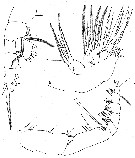 issued from : W. Vervoort in B.A.N.Z. Antarctic Reseach Expedition, Report Ser. B, Vol. III., 1957 [Fig.26]. As Euaetideus giesbrechti. Female: a, right P1 (anterior); b, left Mx2; c, left Mxp.
|
 issued from : W. Vervoort in B.A.N.Z. Antarctic Reseach Expedition, Report Ser. B, Vol. III., 1957 [Fig.27]. As Euaetideus giesbrechti. Female: a-c, P2 to P4 (left legs).
|
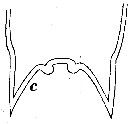 issued from : W. Vervoort in B.A.N.Z. Antarctic Reseach Expedition, Report Ser. B, Vol. III., 1957 [Fig.20 c]. As Euaetideus giesbrechti. Female: distal portion of rostral plate.
|
 issued from : R.N. Wolfenden in Die Marinen Copepoden der Deutschen Südpolar-Expedition 1901-1903, 1911. [p.209, Fig.5]. As Aetidius giesbrechti. Female: a, habitus (lateral); b, rostrum
|
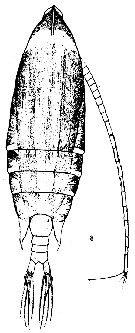 issued from : R.N. Wolfenden in Die Marinen Copepoden der Deutschen Südpolar-Expedition 1901-1903, 1911. [Pl.XXIV, Fig.8]. As Aetidius giesbrechti/ Female: habitus (dorsal).
|
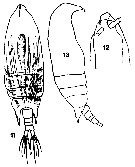 issued from : T. Mori in The pelagic Copepoda from the neighbouring waters of Japan, 1937 (2nd edit., 1964). [Pl.16, Figs.11-13]. Female: 11, habitus (dorsal and lateral, respectively); 12, forehead (ventral).
|
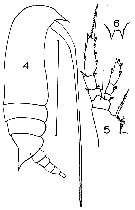 issued from : J.M. Bradford in Mem. N. Z. Oceonogr. Inst., 1972, 54. [p.37, Fig.6 (4-6)]. As Euaetideus giesbrechti. Female (from Kaikoura, New Zealand): 4, habitus (lateral); 5, P5; 6, rostrum. Scale bars: 1 mm (4); 0.1 mm (5). Nota: This specimen appears to be the first record for New Zealand.
|
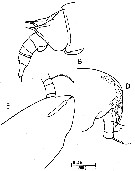 issued from : C. Razouls in Th. Doc. Etat Fac. Sc. Paris VI, 1972, Annexe. [Fig.41, B, D,E]. As Euaetidrus giesbrechti. Female (from Banyuls, G. of Lion): B, thoracic segment 5 and urosome (lateral); D, forehead (lateral); E, forehead (dorsal).
|
 Issued from : W. Giesbrecht in Systematik und Faunistik der Pelagischen Copepoden des Golfes von Neapel und der angrenzenden Meeres-Abschnitte. - Fauna Flora Golf. Neapel, 1892. Atlas von 54 Tafeln. [Taf. 14 , Fig.1 ]. As Aëtidius armatus. Female: 1, A1 (ventral view).
|
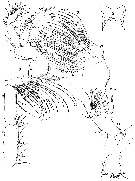 Issued from : W. Giesbrecht in Systematik und Faunistik der Pelagischen Copepoden des Golfes von Neapel und der angrenzenden Meeres-Abschnitte. - Fauna Flora Golf. Neapel, 1892. Atlas von 54 Tafeln. [Taf. 14 , Figs.2-6 ]. As Aëtidius armatus. Female: 2, A2 (anterior view); 3, Mx2 (anterior view); 4, Md (posterior view); 5, rostrum (frontal view); 6, Mxp ( anterior view).
|
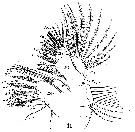 Issued from : W. Giesbrecht in Systematik und Faunistik der Pelagischen Copepoden des Golfes von Neapel und der angrenzenden Meeres-Abschnitte. - Fauna Flora Golf. Neapel, 1892. Atlas von 54 Tafeln. [Taf. 14 , Fig.11 ]. As Aëtidius armatus. Female: 11, Mx1 (posterior view).
|
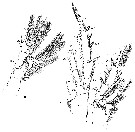 Issued from : W. Giesbrecht in Systematik und Faunistik der Pelagischen Copepoden des Golfes von Neapel und der angrenzenden Meeres-Abschnitte. - Fauna Flora Golf. Neapel, 1892. Atlas von 54 Tafeln. [Taf. 14 , Figs.8-10 ]. As Aëtidius armatus. Female: 8, P4 (anterior view); 9, P2 (anterior view); 10, P1 (anterior view).
|
 Issued from : W. Giesbrecht in Systematik und Faunistik der Pelagischen Copepoden des Golfes von Neapel und der angrenzenden Meeres-Abschnitte. - Fauna Flora Golf. Neapel, 1892. Atlas von 54 Tafeln. [Taf. 14 , Fig.13 ]. As Aëtidius armatus. Male: 13, A1 (ventral view)
|
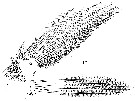 Issued from : W. Giesbrecht in Systematik und Faunistik der Pelagischen Copepoden des Golfes von Neapel und der angrenzenden Meeres-Abschnitte. - Fauna Flora Golf. Neapel, 1892. Atlas von 54 Tafeln. [Taf. 14 , Fig.12 ]. As Aëtidius armatus. Male: 12, Mx1 (ventral view).
|
 Issued from : W. Giesbrecht in Systematik und Faunistik der Pelagischen Copepoden des Golfes von Neapel und der angrenzenden Meeres-Abschnitte. - Fauna Flora Golf. Neapel, 1892. Atlas von 54 Tafeln. [Taf. 14 , Fig.7 ]. As Aëtidius armatus. Male: 7, P5 (posterior view).
|
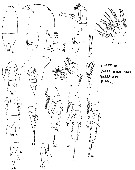 issued from : G.D. Grice in Fish. Bull. Fish and Wildl. Ser., 1962, 61. [p.188, Pl.7, Figs.9-27]. As Euaetideus giesbrechti. Female (from equatorial Pacific): 9, habitus (dorsal); 10, forehead (lateral); 11, posterior part of thorax and urosome (dorsal); 12, same (lateral, left side); 13, urosome (ventral); 14, rostrum; 15, A2; 16, Md; 17, Md (mandible palpus, other side); 18, Mx1; 19, 2nd inner lobe of Mx1; 20, 3rd inner lobe of Mx1; 21, Mx2; 22, P1 (anterior); 23, P2 (posterior); 24, P3 (posterior); 25, 2nd basipodal segment and 1st and 2nd segments of endopod and exopod of P3 (anterior); 26, P4 (posterior); 27, 2nd basipodal segment and 1st and 2nd segments of endopod and exopod of P4 (anterior). Remarks: The chief differences between the Grice' s specimens and those described by Vervoort are (the numbers in parenthesis are thos given by Vervoort): 1- A2: 4 (3) setae on distal segment of exopod; 7 (6) setae on outer lobe and 9 (8) setae on inner lobe of endopod. 2- Mx1: 2nd basal segment with 4 (5) setae; 2nd inner lobe with 3 (2) setae; 3 (4) setae on the 1st segment of the endopod; the 2nd basal segment of the Mx1 in A. australis is shown to have 4 setae, which agrees, in this respect, with the number on the Grice' s specimens.
|
 issued from : H.B. Owre & M. Foyo in Fauna Caribaea, 1, Crustacea, 1: Copepoda. Copepods of the Florida Current. [p.26, Fig.126]. As Euaetideus giesbrechti. Female: 126, rostrum.
|
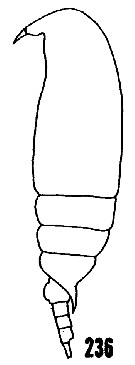 issued from : H.B. Owre & M. Foyo in Fauna Caribaea, 1967, 1, Crustacea, 1: Copepoda. Copepods of the Florida Current. [p.43, Fig.236]. As Euaetideus giesbrechti. Female: 236, habitus (lateral).
|
 issued from : J.M. Bradford in N.Z. Jl Mar. Freshw. Res., 1971, 5 (1). [p.21, Fig.6]. Scaning electron microscope photographs of the integument in Aetideus giesbrechti female: b, anterior head (x 270); d, detail of last thoracic segment (x 3000). Nota: The posterior thoracic segment, anterior head and genital segment are covered with conspicuous chitinous thickenings.
|
 issued from : E.L. Markhaseva in Proc. Zool. Inst. RAN, St. Petersburg, 1996, 268. [p.19, Fig.7]. Female (from 29°17'N, 142°47'E) and Male from Park (1974) R: rostrum (anterior); Ce: forehead (lateral).
|
 Aetideus giesbrechti Aetideus giesbrechti female: 1 - Posterior corners of last thoracic segment prolonged into wing-like lobes pointed at tops, reaching at least the middle of urosomal segment 2. Anterior part of cephalon with crest. 2 - Excavation between rostral rami with 2 thickenings. 3 - Duct between ventral and dorsal parts of spermatheca strongly narrowed . Rostral base not visible in dorsal view. Total body length ± 2 mm.
|
 Aetideus giesbrechti Aetideus giesbrechti male: 1 - Last thoracic segment with points. 2 - Points of last thoracic segment posterior corners not exceeding posterior border of urosomal segment 1 (in dorsal view). 3 - 2nd segment of P5 3.34-4.2 times as long as wide; 4 - Endopod of P2 exceeding border between exopodal segments 2 and 3. External spine at exopodal segment 2 of P1 exceeding the middle of exopodal segment 3.
|
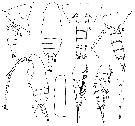 Issued from : T. Park in Fish. Bull., 1974, 72 (1). [p.220, Fig.4]. Female (from G. of Mexico): A, posterior part of body (lateral). Nota: The appendages are identical with those of A. acutus, but the females of the two species are different in the form of spermatheca. Male: B, habitus (dorsal); C-D, posterior part of body (dorsal and lateral, respectively); E, habitus (lateral); F, 19th segment of A1; G, P1 (anterior), H, P2 (anterior); I, P5 (anterior).
| | | | | Ref. compl.: | | | Yamazi, 1958 (p.148, Rem.); Mazza, 1966 (p.70); Sreekumaran Nair & al., 1981 (p.493); Madhupratap & al., 1981 (p.266, fig.1b: abundance vs. geographic transect); Kovalev & Schmeleva, 1982 (p.83); Brenning, 1983 (p.2, spatial distribution, T-S diagram, Rem.); Cummings, 1984 (p.163, Table 2); Tremblay & Anderson, 1984 (p.3, Rem.); Brenning, 1985 a (p.28, Table 2); Ambler & Miller, 1987 (tab.2, 3); Hernandez-Trujillo, 1989 a (tab.1); Cervantes-Duarte & Hernandez-Trujillo, 1989 (tab.3); Kotani & al., 1996 (tab.2); Hure & Krsinic, 1998 (p.46, 100); Gilabert & Moreno, 1998 (tab.1, 2); Suarez-Morales & Gasca, 1998 a (p107); Lapernat, 1999 (p.8, 55); 2000 (tabl.3, 4); Fernandez-Alamo & al., 2000 (p.1139, Appendix); Moraitou-Apostolopoulou & al., 2000 (tab.I); Lapernat & Razouls, 2001 (p.123, tab.1); Holmes, 2001 (p.45); Hsiao & al., 2004 (p.325, tab.1); Gallienne & al., 2004 (p.5, tab.3); Lo & al., 2004 (p.89, tab.1); Dias & Araujo, 2006 (p.28, Rem., chart); Hwang & al., 2007 (p.23); Dur & al., 2007 (p.197, Table IV); Neumann-Leitao & al., 2008 (p.799: Tab.II, fig.6); Fernandes, 2008 (p.465, Tabl.2); RAyon & al., 2008 (p.238, Table 4: Peruvian samples); aybaud & al., 2008 (p.1765, Table A1); C.-Y. Lee & al., 2009 (p.151, Tab.2); Williamson & McGowan, 2010 (p.273, Table 3, Pacific central gyres: N and S) ; Schnack-Schiel & al., 2010 (p.2064, Table 2: E Atlantic subtropical/tropical) ; Dias & al., 2010 (p.230, Table 1); Mazzocchi & Di Capua, 2010 (p.423); Medellin-Mora & Navas S., 2010 (p.265, Tab. 2); Hsiao S.H. & al., 2011 (p.475, Appendix I); Pillai H.U.K. & al., 2011 (p.239, Table 3, vertical distribution); Mazzocchi & al., 2011 (p.1163, fig.6, long-term time-series 1984-2006); Isari & al., 2011 (p.51, Table 2, abundance vs distribution); Andersen N.G. & al., 2011 (p.71, Fig.3: abundance); Tseng L.-C. & al., 2011 (p.47, Table 2, occurrences vs mesh sizes); Uysal & Shmeleva, 2012 (p.909, Table I); Salah S. & al., 2012 (p.155, Tableau 1); Jang M.-C & al., 2012 (p.37, abundance and seasonal distribution); in CalCOFI regional list (MDO, Nov. 2013; M. Ohman, pers. comm.); Tseng & al., 2013 (p.507, seasonal abundance); Lidvanov & al., 2013 (p.290, Table 2, % composition); Hwang & al., 2014 (p.43, Appendix A: seasonal abundance); Bonecker & a., 2014 (p.445, Table II: frequency, horizontal & vertical distributions); Zakaria & al., 2016 (p.1, Table 1); Benedetti & al., 2016 (p.159, Table I, fig.1, functional characters); Marques-Rojas & Zoppi de Roa, 2017 (p.495, Table 1); El Arraj & al., 2017 (p.272, table 2, spatial distribution); Benedetti & al., 2018 (p.1, Fig.2: ecological functional group); Belmonte, 2018 (p.273, Table I: Italian zones); Acha & al., 2020 (p.1, Table 3: occurrence % vs ecoregions). | | | | NZ: | 17 | | |
|
Carte de distribution de Aetideus giesbrechti par zones géographiques
|
| | | | | | | | | | | | 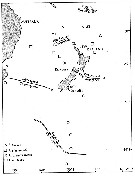 issued from : J.M. Bradford in N.Z. Jl Mar. Freshw. Res., 1971, 5 (1). [p.34, Fig.13]. issued from : J.M. Bradford in N.Z. Jl Mar. Freshw. Res., 1971, 5 (1). [p.34, Fig.13].
Southwest Pacific Ocean showing distribution of four Aetideus species. |
 issued from : U. Brenning in Wiss. Z. Wilhelm-Pieck-Univ. Rostock - 32. Jahrgang 1983. Mat.-nat. wiss. Reihe, 5. [p.1, Figs.1, 2]. issued from : U. Brenning in Wiss. Z. Wilhelm-Pieck-Univ. Rostock - 32. Jahrgang 1983. Mat.-nat. wiss. Reihe, 5. [p.1, Figs.1, 2].
Spatial distribution and T-S Diagram for Aetideus armatus, Aetideus giesbrechti and Aetideopsis carinata from 8° S - 26° N; 16°- 20° W. |
 Issued from S. Razouls in XXIII rd Congress of Athens, 3-11 November 1972. [p.2]. As Aetideus giesbrechti. Oxygen consumed by individual (adult) in the Banyuls Bay and equivalent carbon asked. Issued from S. Razouls in XXIII rd Congress of Athens, 3-11 November 1972. [p.2]. As Aetideus giesbrechti. Oxygen consumed by individual (adult) in the Banyuls Bay and equivalent carbon asked.
(1) Hydrological season in the stability period: Eté = Summer: 18-20 °C; Hiver = Winter: 13-10°C.
Espèces = species; Saison = Season; Lg céph.= cephalothoracic length; an = individual. |
| | | | Loc: | | | Cosmopolite (tropical, temperate), also: Flemish Cape, sub-Antarct. (N Prince Edward Is.), Barren Island, China Seas (East China Sea, South China Sea), Taiwan (SW, E, NW, NE, N: Mienhua Canyon), Korea Strait, Izu-Bonin Trench, Pacific (central gyres: N and S), CalCOFI region, Peru, N Chile;, Station "S" (32°10'N, 64°30'W).
Type locality: West of South Africa. | | | | N: | 164 | | | | Lg.: | | | (1) F: 2,2; (5) F: 2,1; (25) F: 2,04; (35) F: 1,98-1,92; (37) F: 2,2-1,8; M: 1,6-1,52; (39) F: 1,98; (73) F: 2,14-1,71; (101) F: 1,97-1,95; (116) F: 1,96; (199) F: 1,98-1,82; (202) F: 1,5-2,04; M: 1,1; (204) F: 2-1,8; M: 1,7-1,62; (206) F: 2,08-1,84; M: 1,6-1,52; (207) F: 2,1-1,92; (237) F: 1,5; M: 1,1; (244) F: 2,2; (290) F: 1,5-1,8; (340) F: 1,9; (449) F: 2,1; (530) F: 1,9; (866) F: 1,8-2,2; M: 1,52-1,7; (991) F: 1,8-2,2; M: 1,52-1,6; (1109) F: 2,06-2,16; (1230) F: 1,95-2,04; {F: 1,50-2,20; M: 1,10-1,70}
The mean female size is 1.921 mm (n = 36; SD = 0.2264), and the mean male size is 1.508 mm (n = 12; SD = 0.2012). The size ratio (male : female) is approximately 0.81. | | | | Rem.: | épi-mésopélagique, 3000 m (Médit.: off Malte).
Voir aussi les remarques en anglais | | | Dernière mise à jour : 19/06/2023 | |
|
|
 Toute utilisation de ce site pour une publication sera mentionnée avec la référence suivante : Toute utilisation de ce site pour une publication sera mentionnée avec la référence suivante :
Razouls C., Desreumaux N., Kouwenberg J. et de Bovée F., 2005-2025. - Biodiversité des Copépodes planctoniques marins (morphologie, répartition géographique et données biologiques). Sorbonne Université, CNRS. Disponible sur http://copepodes.obs-banyuls.fr [Accédé le 03 décembre 2025] © copyright 2005-2025 Sorbonne Université, CNRS
|
|
 |
 |































